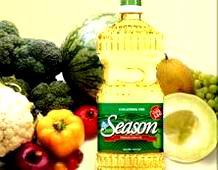How to distinguish the quality of cooking oil
Scientists are encouraging to use vegetable oil instead of fat to prevent cardiovascular disease. However, if using poor quality oil, the harm is no less. And it is not easy to distinguish which oil is good.

(Photo: VNN)
In order to avoid mistakenly buying fake oil, poor quality oil, consumers need to have certain knowledge, through sensory methods to comment on taste, state, color .
Evaluate the smell of oil
First of all, wash your hands thoroughly, do not use scented soaps to avoid strange odors, causing interference when commenting. Take a clean chopstick to the oil, then put it into the left palm, use your index finger to move, spread the oil to the palm and bring it to the nose. Good quality oil has a normal smell, distinct characteristic of each type of oil, no rancid, no smell, no smell, no smell, no strange smell, other unpleasant smells.
Review the taste of oil
Take a clean chopstick in the oil and 1-2 drops in the hollow of the hand. Use the tongue to taste whether the oil has a strange taste. If the oil is of good quality, the taste will be normal, not acrid, not bitter, not sour, but only the specific flavor of the product, depending on the type of oil. When finished, remove and rinse thoroughly.
Evaluate the transparent state of oil
If the oil is of high quality, very little water and impurity content will be transparent. If not transparent, depending on the degree of turbidity more or less, we can evaluate the low or high oil quality, with more water and impurity content.
Observe both the glowing colors of the oil to distinguish oils and qualities. If the oil is of good quality, it will be dark yellow, normal quality oil is light yellow. If it is rapeseed oil, it is still yellow in yellow, if peanut oil is light yellow or light orange; if it is cotton seed oil, the color is lighter.
Detect blended oil
To detect cooking oil mixed with oil, take a little oil into the test tube, add a few drops of sulfuric acid, boil 60 degrees C for 15 minutes. If there is oil, it will see the solution scattering like a cloud, if too much oil, it will become a lumpy plate.
To detect the addition of starch to the cooking oil, take some oil, the basket adds a few drops of iodine, the oil appears in blue.
Sesame oil is a precious oil, when newly produced, it has a pinkish yellow color, giving a clear light, no sedimentation at the bottom, no layering, a distinct taste. If mixed, even if only 0.5% of the ingredients with water can be detected: The oil will not be very transparent, not as thick as pure oil, layered, smells do not taste delicious, again smells different because the oil has been dissolved, oxidized, metamorphosed, damaged .
- The habit of using oil wrongly can easily lead to liver cancer
- 6 healthy cooking oils
- How to use the most beneficial cooking oil
- 7 tips for using healthy cooking oil
- How to distinguish real milk and very good fake milk
- Regular cooking can live longer
- How to identify fake gas, poor quality gas
- How to distinguish Korean and Chinese needle mushrooms
- Harmful effects of cooking oil on the body
- 4 cooking habits are easy to cause cancer
- How to distinguish real dry beef and fake super dry beef
- Great cooking tips that few people know
 Green tea cleans teeth better than mouthwash?
Green tea cleans teeth better than mouthwash? Death kiss: This is why you should not let anyone kiss your baby's lips
Death kiss: This is why you should not let anyone kiss your baby's lips What is salmonellosis?
What is salmonellosis? Caution should be exercised when using aloe vera through eating and drinking
Caution should be exercised when using aloe vera through eating and drinking